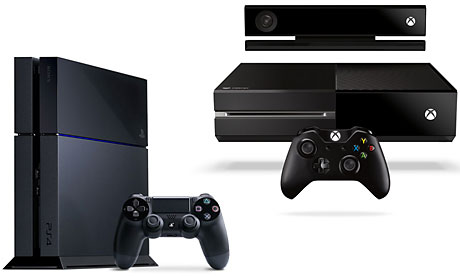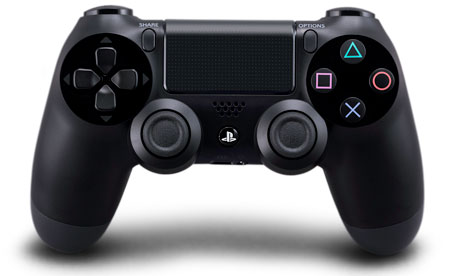Xbox One v PS4: the complete comparison

Some are calling it the best E3 in five years – others insist it's the best of all time. But whatever hyperbole gets attached to last week's gaming conference, we can all agree on the focus: Xbox One v PS4.
Amid the chaos of the LA convention centre, Microsoft and Sony pitched their stands barely feet from each other, separated only by a sliver of carpet, a no-man's land of technological rivalry. The two companies then spent three days hurling PR at each other, deafening attendees with their arsenals of mega hype. It was confusing, it was enraging, it was console war – and the first casualty of console war is sense.
So, what did it all mean? Who won, who lost? What do these machines actually do? Here is a quick guide to the next-generation as it currently stands, complete with hardware, services and game announcements. Next stop: release dates and a shift of the skirmish to a hundred thousand shop shelves. This fight has only just begun.
UPDATES – 20 JUNE: The Second Screens section has been updated to clarify Remote Play; the Hardware section has been updated with a developer comment on system memory; the DRM section has been altered to reflect Microsoft's u-turn on game restrictions
Official sites
Before you start, why not check out what the console makers want you to know about their machines? Xbox one is here; PS4 is right over there.
Hardware
Well, black is certainly back, as AC/DC once sort of nearly put it (or Public Enemy, for that matter, but we're getting off the point now). For this generation we have two rather large slabs of dark plastic, one shaped like an early eighties video recorder, the other slightly slanted to give a hint of dynamism. They are monolithic, almost architectural, and they are designed to slide in under your living room TV and then command attention from everyone in the room.
Technically, they are hugely similar: eight-core processors (both reported to be running at a frequency of 1.6GHz), custom AMD graphics processors, Blu-ray drives. But there are some fundamental differences. The two GPUs employ AMD's latest Graphics Core Next architecture, which is divided into working blocks known as Compute Units. The PS4 version has 18 CUs generating 1.84 teraflops of processing power, while the Xbox one has only 12 CUs; which, in theory , gives Sony's machine a 50% advantage in terms of raw shader performance (for example, lighting and other graphics effects). It's never quite this simple because other design and technical elements of the SoC can affect performance, but it's certainly an indication that there is more graphics grunt there for PS4.
Sony's machine also uses 8GB of GDDR5 memory with a bandwidth of 176GB/sec as opposed to the Xbox One with its 8GB of DDR3 RAM. GDDR5 memory is optimised for high bandwidth, which is perfect for use in graphics calculations, but also has higher latency than DDR3 RAM, which would be a problem for a general purpose CPU. However, because the PS4 architecture places the GPU and CPU on the same die, the latency between the two may be minimalised. In short, the adoption of a graphics-friendly form of memory may work to PS4's advantage as agames-targeted machine – even though GDDR5 is more expensive to implement. There's a thorough summing up of the system design here.
It's also worth reading the detailed overview of the technologies at AnandTech, though. The exhaustive article points out that the Xbox One architecture is designed with a variety of considerations beyond gaming – especially implementation with other MS platforms – and this shows in the tech specs.
A developer's view
We asked an experienced games coder about the differences between Xbox One and PS4's approach to system memory. He has asked to remain anonymous, but this is what he wrote...
We asked an experienced games coder about the differences between Xbox One and PS4's approach to system memory. He has asked to remain anonymous, but this is what he wrote...
"Memory-wise there are really deep areas you can get into on how Sony has optimised certain paths to access the RAM. Microsoft will hopefully be doing similar stuff to that, I imagine – we're only disclosed on PS4 so I don't know for sure, they're not dumb though.
"Regarding the RAM type, however, GDDR5 equals 176gb/sec, DDR3 equals 68gb/sec – I don't know the exact numbers for the Xbox One RAM but it'll be around that. GDDR5 is slightly higher latency, which means the time between requesting a piece of data and getting it to the CPU/GPU to work with can be slightly longer than with DDR3. This latency can be hidden by well-written code on CPU and normally is hidden well by GPUs due to how their pipelines work (which is why GDDR is normally found on GPU's).
"Ultimately though, that 2.5x faster bandwidth number means that a larger amount of data can be taken from RAM, processed by the CPU (or more importantly on these new architectures, the Compute Units on the GPU) and spat back out to RAM to either process again or render. At the end of the day, everything in games comes down to: 'grab information'; 'transform that data somehow'; 'spit it back out' – so being faster at this is a very good thing.
"Microsoft is winning bandwidth back for the GPU through the 32MB ESRAM (102gb/sec I believe, and assuming you're using this RAM a lot, it means that the total Microsoft bandwidth is 168gb/sec); this will even things back out a bit but require a bit of extra management by developers and it is only 32MB which limits the amount of uses.
"This kind of architecture with faster RAM for the GPU to use for framebuffers (the block of data storing the image being rendererd out or nowadays temporary graphic buffers storing lighting/material information) is something developers are used to working with, but it's more complex than the approach needed on the PS4."
Controllers
With its new touchpad, the DualShock 4 is the most obviously changed of the two joypads, and Sony has also added a speaker for up-close, player-specific audio. Also important is the new Share button which will let PlayStation gamers record footage of their virtual feats with which to impress/spam their friends.
The Xbox One controller, which apparently went through over 200 prototype stages and features 40 improvements, is more subtle – it has improved triggers that boast greater analogue sensitivity as well as their own dedicated rumble packs. Meanwhile, the D-pad is now a cross shape (good for fighting games) and the sticks are more comfortable to grip. Oh and there's a headphone socket, too. Both controllers look and feel really nice, and while the DualShock has more gimmicks, the Xbox equivalent features smart ergonomics and great gaming comfort.

Multimedia and social features
Both consoles will have varied video-on-demand support, involving multiple content partners. Xbox One looks to have the most advanced and ambitious offering, allowing owners to feed in their cable/satellite channels and then control them via the Xbone voice and gesture controls. Microsoft's machine will also allow seamless movement between TV, video content and games, while premium TV content such as live sports will be augmented with exclusive social and gaming features – which haven't yet been properly explained (or clearly rolled out beyond US-centric deals). And of course, both machines allow you to watch Blu-ray and DVD movie discs, and both support 4K output when that becomes an issue. Will that ever become an issue?





